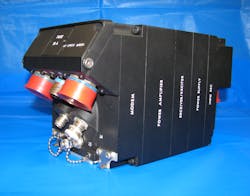Collins Aerospace to build 11,313 AN/ARC-210 secure avionics radios for U.S. and allied military aviation
PATUXENT RIVER NAS, Md. – Military radio communications experts at the Raytheon Technologies Corp. Collins Aerospace segment in Cedar Rapids, Iowa, will provide 11,313 AN/ARC-210 avionics radios and related equipment for U.S. and foreign military aircraft under terms of a $316.7 million order announced Tuesday.
Officials of the Naval Air Warfare Center Aircraft Division at Patuxent River Naval Air Station, Md., are asking Collins Aerospace to provide AN/ARC-210(v) radios for more than 400 strategic and tactical airborne, seaborne, and land based platforms for the Navy, Marine Corps, Army, Coast Guard, other government agencies and foreign military sales customers.
The AN/ARC-210 radio operates over frequencies from 30 to 512 MHz, covering UHF and VHF bands with AM, FM, and satellite communications. It includes embedded anti-jam waveforms like Have Quick and SINCGARS, and other data link and secure communications features for battlefield interoperability and transfer of data, voice, and imagery. The radios communicate with other avionics over a MIL-STD-1553 data bus.
Related: Secure military and civil airborne software-defined radio introduced by Rohde & Schwarz
The ARC-210 aircraft radio provides VHF close-air-support radio communications on 30-88 MHz frequencies; navigation on 108-118 MHz; air traffic control on 118-137 MHz; land mobile communications on 137-156 MHz; and maritime communications on 156-174 MHz.
The radios also provide aircraft with UHF military and homeland defense communications on 225-512 MHz frequencies; and public-safety communications on 806-824, 851-869, 869-902, and 935-941 frequencies.
The AN/ARC-210 also has a connector in the back of the radio for an Ethernet input for network-centric warfare. It also provides embedded programmable information security per the U.S. National Security Agency (NSA) Cryptographic Modernization Initiative.
Collins won a $10.8 million order last December to integrate the company's programmable crypto engine in versions of the company's AN/ARC-210 airborne radios. Collins cryptography experts are using Tactical Secure Voice Suite B algorithms to secure the ARC-210 radios.
Company military communications experts launched a program in about 2005 to develop the company’s own programmable crypto engine and embed it in products ARC-210. Embedding crypto in the radio saves space and weight, and enables the company either to make more lightweight radios or add capability.
Tactical Secure Voice Suite B algorithms are approved by the U.S. National Security Agency (NSA) at Fort Mead, Md. Suite B non-classified crypto algorithms are developed in private industry, not in government. NSA experts verify the effectiveness of these algorithms and certify them for deployed military systems.
On Tuesday's order Collins Aerospace will do the work in Cedar Rapids, Iowa, and should be finished by September 2023. For more information contact Raytheon Technologies Collins Aerospace online at www.rtx.com/Our-Company/Our-Businesses/ca, or the Naval Air Warfare Center Aircraft Division at www.navair.navy.mil/nawcad.
About the Author
John Keller
Editor-in-Chief
John Keller is the Editor-in-Chief, Military & Aerospace Electronics Magazine--provides extensive coverage and analysis of enabling electronics and optoelectronic technologies in military, space and commercial aviation applications. John has been a member of the Military & Aerospace Electronics staff since 1989 and chief editor since 1995.
